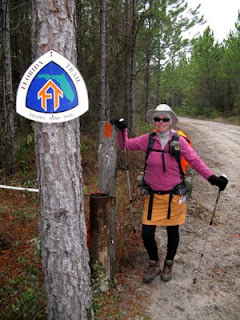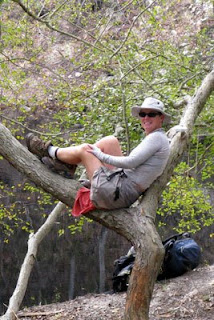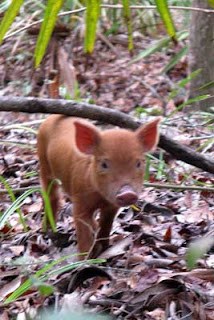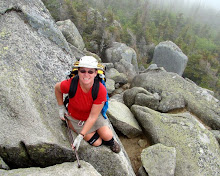 We made to to Apalachicola. This is a big milestone for me. When we drove up here a year or so ago for the Monkey Creek F-Troop project I remember thinking that it seemed like a long way from home and it would take forever to hike to here. It is, and it was!
We made to to Apalachicola. This is a big milestone for me. When we drove up here a year or so ago for the Monkey Creek F-Troop project I remember thinking that it seemed like a long way from home and it would take forever to hike to here. It is, and it was!The pines of the southern Apalachicola NF range from mature to young trees. Throw in a couple of burned out areas, and a very damp, dark mixed forest and you've got a very pleasant forest hike that emerged on the banks of the Sopchoppy River.
The Sopchoppy seemed to be flowing fairly fast. We sat for a while at lunchtime watching the bubbles flowing rapidly downstream and a couple of leaves running back upstream on a powerful eddy. The hike along the Sopchoppy ravine was great: Lots of bridges, and many great views of the river and the massive cypresses.
 Soon we crossed Monkey Creek, a small creek which flows into the Sopchoppy just downstream of the bridge. The bridge is significant to us because we spent a week with Florida Trail’s F-Troop last year helping to build this 80’ bridge over the creek. It felt pretty good walking over the completed bridge, as we had had to leave before it was completed. Monkey Creek was flowing surprisingly low and slow compared to the Sopchoppy, which was good news for us, as it means that Bradwell Bay, which is drained by Monkey Creek, may be drier than we were expecting.
Soon we crossed Monkey Creek, a small creek which flows into the Sopchoppy just downstream of the bridge. The bridge is significant to us because we spent a week with Florida Trail’s F-Troop last year helping to build this 80’ bridge over the creek. It felt pretty good walking over the completed bridge, as we had had to leave before it was completed. Monkey Creek was flowing surprisingly low and slow compared to the Sopchoppy, which was good news for us, as it means that Bradwell Bay, which is drained by Monkey Creek, may be drier than we were expecting. Nonetheless, we set out to hike the Bradwell Bay Wilderness with some trepidation. We are camped on the Sopchoppy river, which had risen several feet since we arrived a couple days before. Bradwell Bay is a 3 mile wilderness swamp area which is drained by Monkey creek, it’s only outlet. Despite seeing Monkey Creek in a fairly low flow, we are rather concerned that there may be a lot of water in the swamp, but that it just hasn’t started draining yet. As it turns out, our fears were unfounded. Six miles into the hike we crossed Monkey Creek easily. It was a mere trickle past the dreaded “hole” and we barely got the soles of our boots wet. After that the swamp was very dry, though rather overgrown and in need of some maintenance.
Nonetheless, we set out to hike the Bradwell Bay Wilderness with some trepidation. We are camped on the Sopchoppy river, which had risen several feet since we arrived a couple days before. Bradwell Bay is a 3 mile wilderness swamp area which is drained by Monkey creek, it’s only outlet. Despite seeing Monkey Creek in a fairly low flow, we are rather concerned that there may be a lot of water in the swamp, but that it just hasn’t started draining yet. As it turns out, our fears were unfounded. Six miles into the hike we crossed Monkey Creek easily. It was a mere trickle past the dreaded “hole” and we barely got the soles of our boots wet. After that the swamp was very dry, though rather overgrown and in need of some maintenance. I was rather disappointed that the trail itself was in such overgrown condition. I understand that this is a very wet area usually, and therefore hard to maintain, but to my knowledge it has now been dry for several months, maybe historically dry, and I think it would have been a prime opportunity to get into this section to improve the trail conditions for when it becomes flooded again. It was a good hike, but I would have enjoyed the massive virgin tree stands more if I wasn't having to spend so much time looking for blazes, fending off branches and concentrating on footing.
View more photos in my Picasa album








